Australian Commercial Law: Consumer Guarantees and Negligence
VerifiedAdded on 2023/06/05
|9
|3021
|398
Homework Assignment
AI Summary
This assignment analyzes an Australian commercial law case involving defective goods and negligence. Part A focuses on a consumer, Ann, who purchased contaminated salami and suffered physical and financial damages. It examines the application of the Australian Consumer Law (ACL), specifically sections 54 (acceptable quality) and 138 (manufacturer's liability), to determine if a breach of consumer guarantees occurred and if Ann can claim compensation from the manufacturer, Smallgoods Pty Ltd, considering the expiry date. Part B explores additional rights Ann may be entitled to, including breaches of sections 55 (fitness for purpose) and 64 (exclusion clauses). The assignment concludes that Ann can claim a refund and that the supplier breached section 64. Question 2 analyzes a negligence tort case involving Shanti, an employee at a shoe factory, and the manager's negligent conduct. It assesses the presence of duty of care, breach of duty, and damages to determine if a negligence tort is established, using the 'neighbor test' and considering reasonable measures to prevent harm. The assignment examines the concepts of duty of care, breach of duty, and causation to establish negligence.
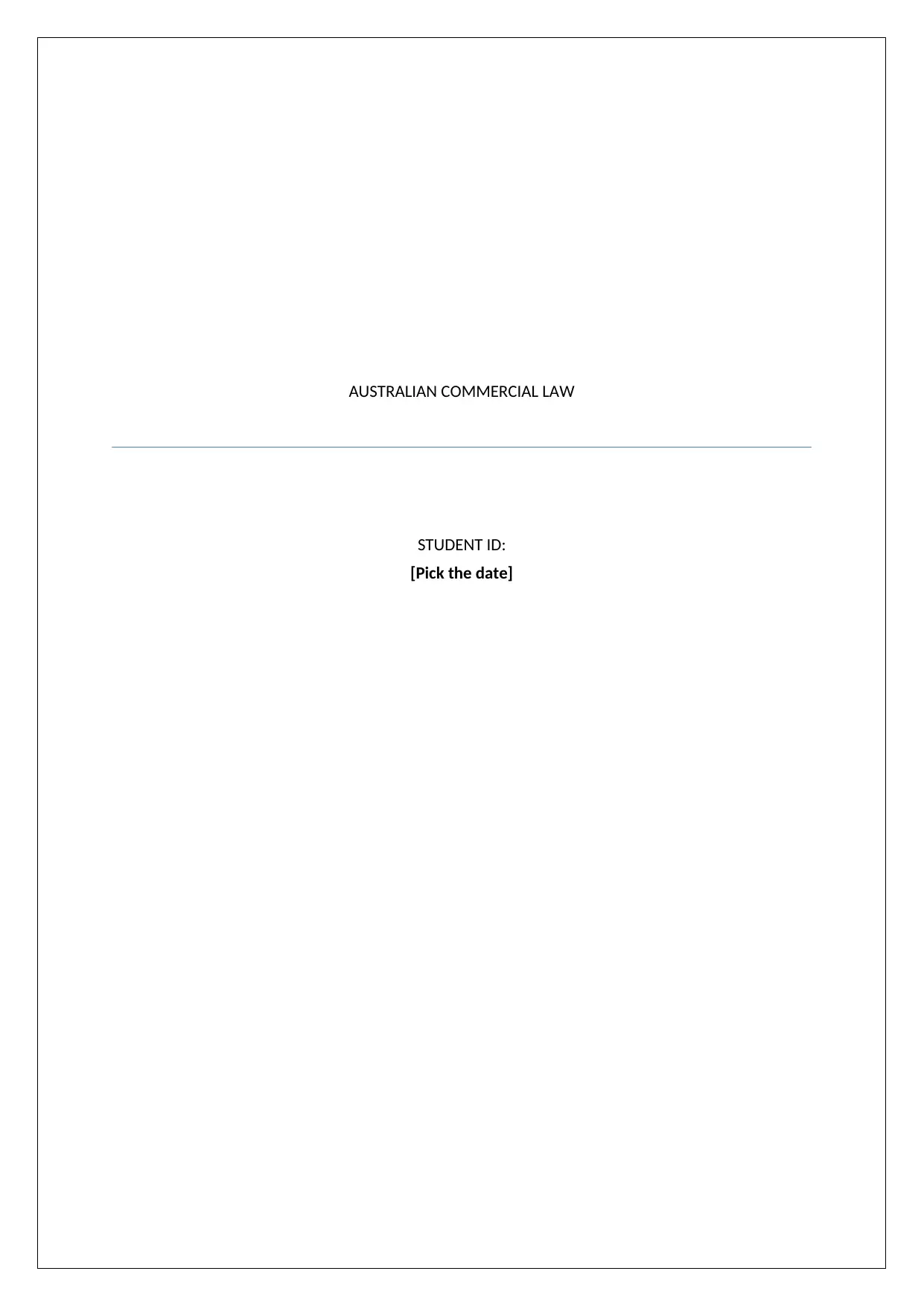
AUSTRALIAN COMMERCIAL LAW
STUDENT ID:
[Pick the date]
STUDENT ID:
[Pick the date]
Paraphrase This Document
Need a fresh take? Get an instant paraphrase of this document with our AI Paraphraser
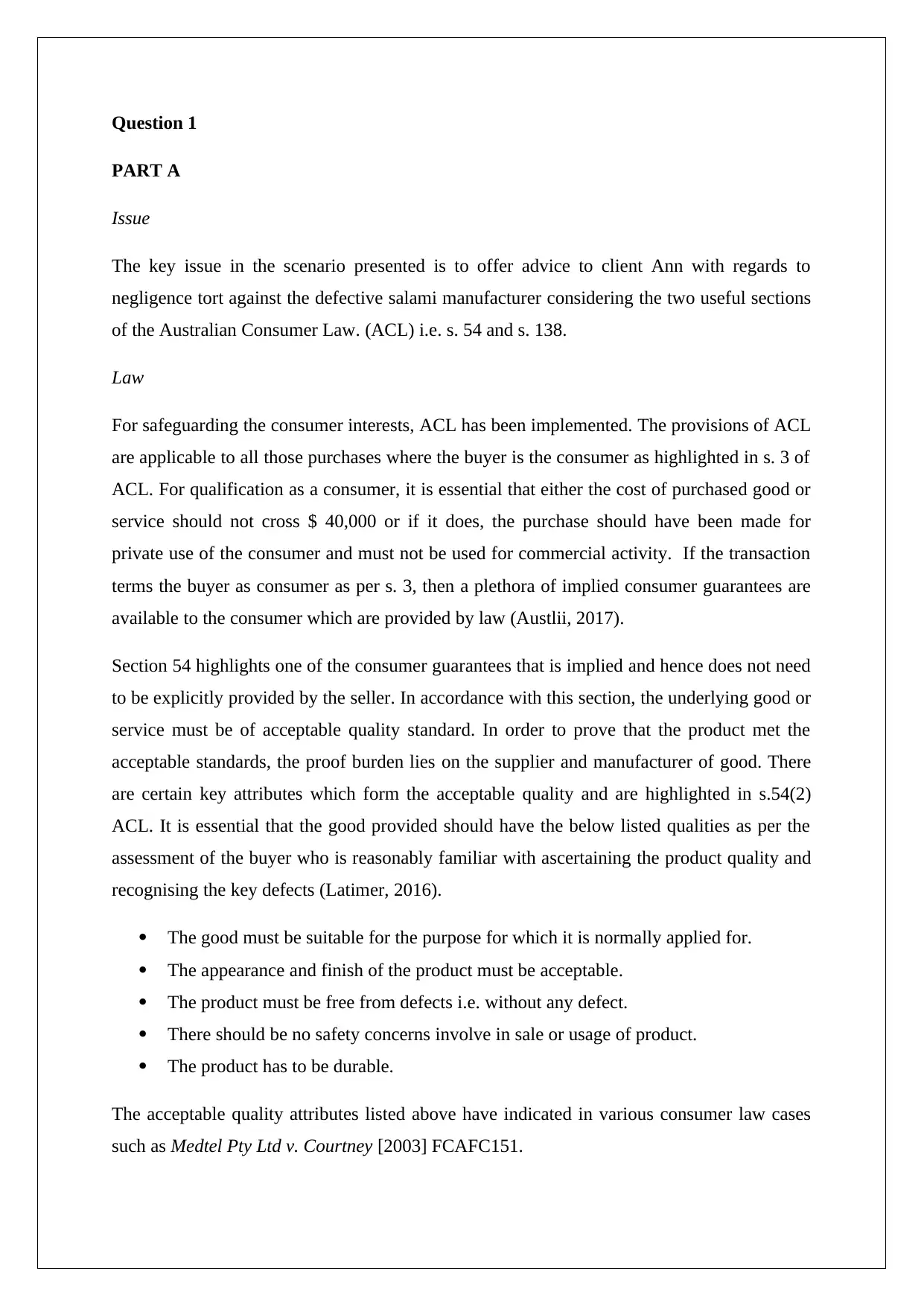
Question 1
PART A
Issue
The key issue in the scenario presented is to offer advice to client Ann with regards to
negligence tort against the defective salami manufacturer considering the two useful sections
of the Australian Consumer Law. (ACL) i.e. s. 54 and s. 138.
Law
For safeguarding the consumer interests, ACL has been implemented. The provisions of ACL
are applicable to all those purchases where the buyer is the consumer as highlighted in s. 3 of
ACL. For qualification as a consumer, it is essential that either the cost of purchased good or
service should not cross $ 40,000 or if it does, the purchase should have been made for
private use of the consumer and must not be used for commercial activity. If the transaction
terms the buyer as consumer as per s. 3, then a plethora of implied consumer guarantees are
available to the consumer which are provided by law (Austlii, 2017).
Section 54 highlights one of the consumer guarantees that is implied and hence does not need
to be explicitly provided by the seller. In accordance with this section, the underlying good or
service must be of acceptable quality standard. In order to prove that the product met the
acceptable standards, the proof burden lies on the supplier and manufacturer of good. There
are certain key attributes which form the acceptable quality and are highlighted in s.54(2)
ACL. It is essential that the good provided should have the below listed qualities as per the
assessment of the buyer who is reasonably familiar with ascertaining the product quality and
recognising the key defects (Latimer, 2016).
The good must be suitable for the purpose for which it is normally applied for.
The appearance and finish of the product must be acceptable.
The product must be free from defects i.e. without any defect.
There should be no safety concerns involve in sale or usage of product.
The product has to be durable.
The acceptable quality attributes listed above have indicated in various consumer law cases
such as Medtel Pty Ltd v. Courtney [2003] FCAFC151.
PART A
Issue
The key issue in the scenario presented is to offer advice to client Ann with regards to
negligence tort against the defective salami manufacturer considering the two useful sections
of the Australian Consumer Law. (ACL) i.e. s. 54 and s. 138.
Law
For safeguarding the consumer interests, ACL has been implemented. The provisions of ACL
are applicable to all those purchases where the buyer is the consumer as highlighted in s. 3 of
ACL. For qualification as a consumer, it is essential that either the cost of purchased good or
service should not cross $ 40,000 or if it does, the purchase should have been made for
private use of the consumer and must not be used for commercial activity. If the transaction
terms the buyer as consumer as per s. 3, then a plethora of implied consumer guarantees are
available to the consumer which are provided by law (Austlii, 2017).
Section 54 highlights one of the consumer guarantees that is implied and hence does not need
to be explicitly provided by the seller. In accordance with this section, the underlying good or
service must be of acceptable quality standard. In order to prove that the product met the
acceptable standards, the proof burden lies on the supplier and manufacturer of good. There
are certain key attributes which form the acceptable quality and are highlighted in s.54(2)
ACL. It is essential that the good provided should have the below listed qualities as per the
assessment of the buyer who is reasonably familiar with ascertaining the product quality and
recognising the key defects (Latimer, 2016).
The good must be suitable for the purpose for which it is normally applied for.
The appearance and finish of the product must be acceptable.
The product must be free from defects i.e. without any defect.
There should be no safety concerns involve in sale or usage of product.
The product has to be durable.
The acceptable quality attributes listed above have indicated in various consumer law cases
such as Medtel Pty Ltd v. Courtney [2003] FCAFC151.
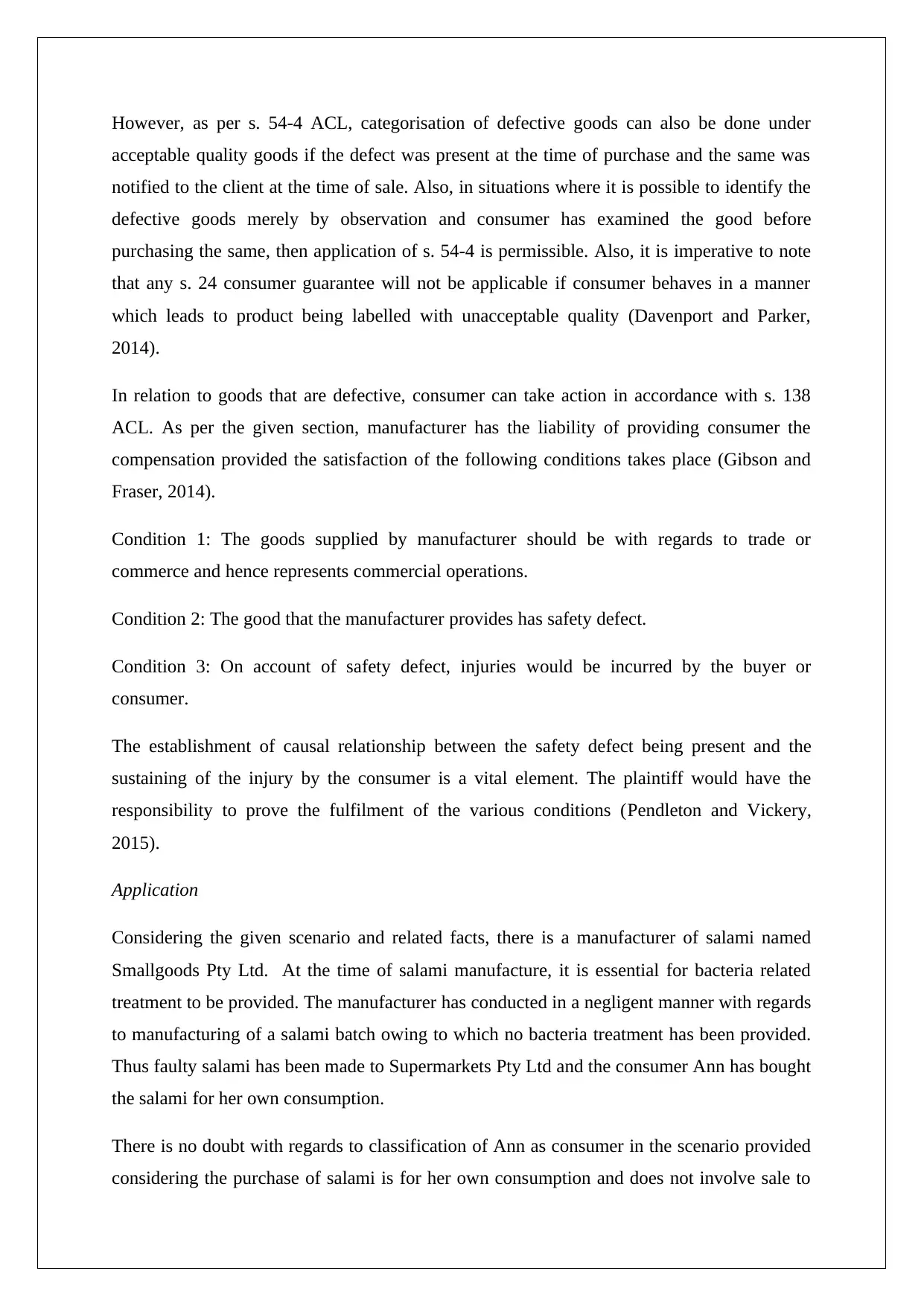
However, as per s. 54-4 ACL, categorisation of defective goods can also be done under
acceptable quality goods if the defect was present at the time of purchase and the same was
notified to the client at the time of sale. Also, in situations where it is possible to identify the
defective goods merely by observation and consumer has examined the good before
purchasing the same, then application of s. 54-4 is permissible. Also, it is imperative to note
that any s. 24 consumer guarantee will not be applicable if consumer behaves in a manner
which leads to product being labelled with unacceptable quality (Davenport and Parker,
2014).
In relation to goods that are defective, consumer can take action in accordance with s. 138
ACL. As per the given section, manufacturer has the liability of providing consumer the
compensation provided the satisfaction of the following conditions takes place (Gibson and
Fraser, 2014).
Condition 1: The goods supplied by manufacturer should be with regards to trade or
commerce and hence represents commercial operations.
Condition 2: The good that the manufacturer provides has safety defect.
Condition 3: On account of safety defect, injuries would be incurred by the buyer or
consumer.
The establishment of causal relationship between the safety defect being present and the
sustaining of the injury by the consumer is a vital element. The plaintiff would have the
responsibility to prove the fulfilment of the various conditions (Pendleton and Vickery,
2015).
Application
Considering the given scenario and related facts, there is a manufacturer of salami named
Smallgoods Pty Ltd. At the time of salami manufacture, it is essential for bacteria related
treatment to be provided. The manufacturer has conducted in a negligent manner with regards
to manufacturing of a salami batch owing to which no bacteria treatment has been provided.
Thus faulty salami has been made to Supermarkets Pty Ltd and the consumer Ann has bought
the salami for her own consumption.
There is no doubt with regards to classification of Ann as consumer in the scenario provided
considering the purchase of salami is for her own consumption and does not involve sale to
acceptable quality goods if the defect was present at the time of purchase and the same was
notified to the client at the time of sale. Also, in situations where it is possible to identify the
defective goods merely by observation and consumer has examined the good before
purchasing the same, then application of s. 54-4 is permissible. Also, it is imperative to note
that any s. 24 consumer guarantee will not be applicable if consumer behaves in a manner
which leads to product being labelled with unacceptable quality (Davenport and Parker,
2014).
In relation to goods that are defective, consumer can take action in accordance with s. 138
ACL. As per the given section, manufacturer has the liability of providing consumer the
compensation provided the satisfaction of the following conditions takes place (Gibson and
Fraser, 2014).
Condition 1: The goods supplied by manufacturer should be with regards to trade or
commerce and hence represents commercial operations.
Condition 2: The good that the manufacturer provides has safety defect.
Condition 3: On account of safety defect, injuries would be incurred by the buyer or
consumer.
The establishment of causal relationship between the safety defect being present and the
sustaining of the injury by the consumer is a vital element. The plaintiff would have the
responsibility to prove the fulfilment of the various conditions (Pendleton and Vickery,
2015).
Application
Considering the given scenario and related facts, there is a manufacturer of salami named
Smallgoods Pty Ltd. At the time of salami manufacture, it is essential for bacteria related
treatment to be provided. The manufacturer has conducted in a negligent manner with regards
to manufacturing of a salami batch owing to which no bacteria treatment has been provided.
Thus faulty salami has been made to Supermarkets Pty Ltd and the consumer Ann has bought
the salami for her own consumption.
There is no doubt with regards to classification of Ann as consumer in the scenario provided
considering the purchase of salami is for her own consumption and does not involve sale to
⊘ This is a preview!⊘
Do you want full access?
Subscribe today to unlock all pages.

Trusted by 1+ million students worldwide
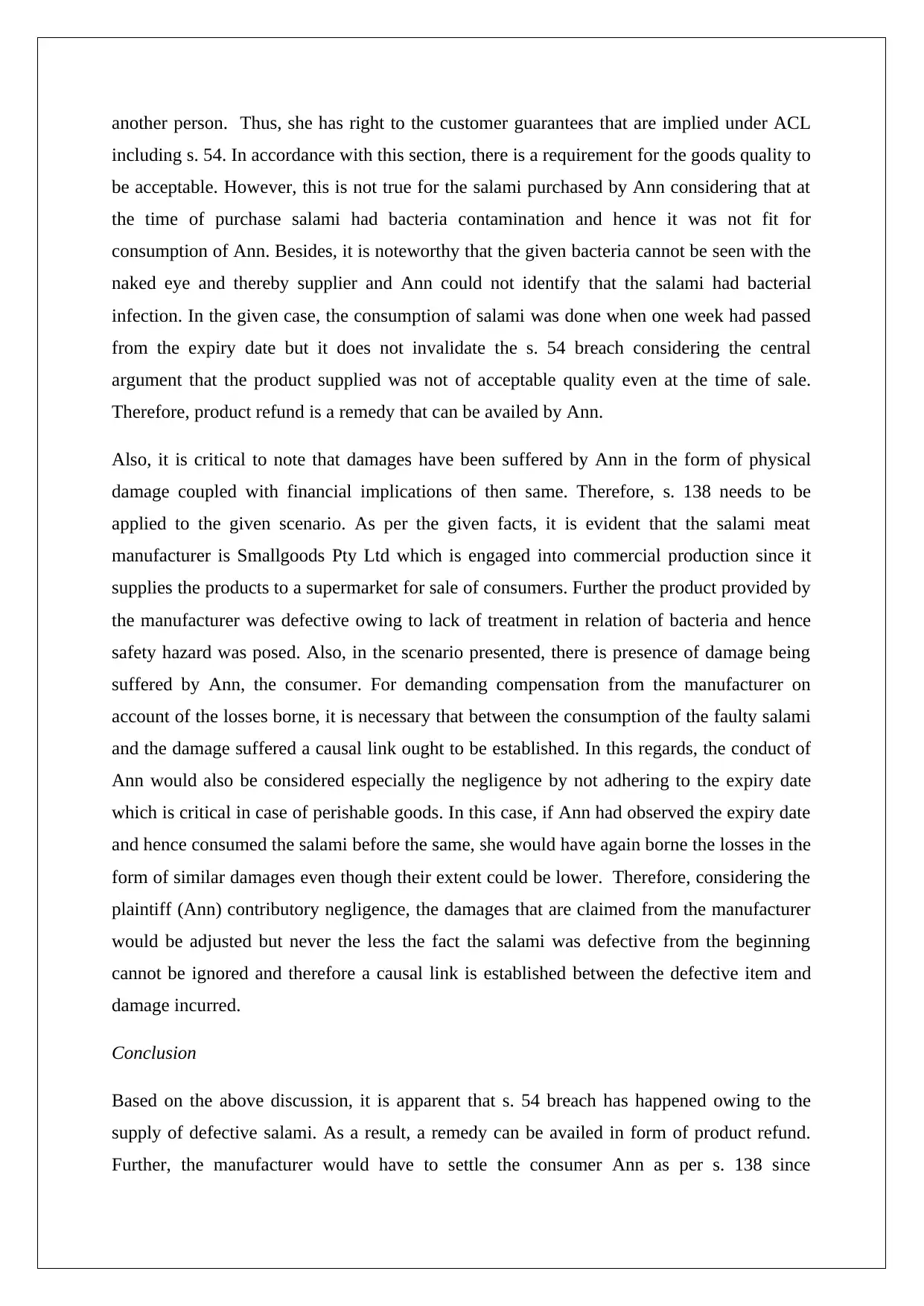
another person. Thus, she has right to the customer guarantees that are implied under ACL
including s. 54. In accordance with this section, there is a requirement for the goods quality to
be acceptable. However, this is not true for the salami purchased by Ann considering that at
the time of purchase salami had bacteria contamination and hence it was not fit for
consumption of Ann. Besides, it is noteworthy that the given bacteria cannot be seen with the
naked eye and thereby supplier and Ann could not identify that the salami had bacterial
infection. In the given case, the consumption of salami was done when one week had passed
from the expiry date but it does not invalidate the s. 54 breach considering the central
argument that the product supplied was not of acceptable quality even at the time of sale.
Therefore, product refund is a remedy that can be availed by Ann.
Also, it is critical to note that damages have been suffered by Ann in the form of physical
damage coupled with financial implications of then same. Therefore, s. 138 needs to be
applied to the given scenario. As per the given facts, it is evident that the salami meat
manufacturer is Smallgoods Pty Ltd which is engaged into commercial production since it
supplies the products to a supermarket for sale of consumers. Further the product provided by
the manufacturer was defective owing to lack of treatment in relation of bacteria and hence
safety hazard was posed. Also, in the scenario presented, there is presence of damage being
suffered by Ann, the consumer. For demanding compensation from the manufacturer on
account of the losses borne, it is necessary that between the consumption of the faulty salami
and the damage suffered a causal link ought to be established. In this regards, the conduct of
Ann would also be considered especially the negligence by not adhering to the expiry date
which is critical in case of perishable goods. In this case, if Ann had observed the expiry date
and hence consumed the salami before the same, she would have again borne the losses in the
form of similar damages even though their extent could be lower. Therefore, considering the
plaintiff (Ann) contributory negligence, the damages that are claimed from the manufacturer
would be adjusted but never the less the fact the salami was defective from the beginning
cannot be ignored and therefore a causal link is established between the defective item and
damage incurred.
Conclusion
Based on the above discussion, it is apparent that s. 54 breach has happened owing to the
supply of defective salami. As a result, a remedy can be availed in form of product refund.
Further, the manufacturer would have to settle the consumer Ann as per s. 138 since
including s. 54. In accordance with this section, there is a requirement for the goods quality to
be acceptable. However, this is not true for the salami purchased by Ann considering that at
the time of purchase salami had bacteria contamination and hence it was not fit for
consumption of Ann. Besides, it is noteworthy that the given bacteria cannot be seen with the
naked eye and thereby supplier and Ann could not identify that the salami had bacterial
infection. In the given case, the consumption of salami was done when one week had passed
from the expiry date but it does not invalidate the s. 54 breach considering the central
argument that the product supplied was not of acceptable quality even at the time of sale.
Therefore, product refund is a remedy that can be availed by Ann.
Also, it is critical to note that damages have been suffered by Ann in the form of physical
damage coupled with financial implications of then same. Therefore, s. 138 needs to be
applied to the given scenario. As per the given facts, it is evident that the salami meat
manufacturer is Smallgoods Pty Ltd which is engaged into commercial production since it
supplies the products to a supermarket for sale of consumers. Further the product provided by
the manufacturer was defective owing to lack of treatment in relation of bacteria and hence
safety hazard was posed. Also, in the scenario presented, there is presence of damage being
suffered by Ann, the consumer. For demanding compensation from the manufacturer on
account of the losses borne, it is necessary that between the consumption of the faulty salami
and the damage suffered a causal link ought to be established. In this regards, the conduct of
Ann would also be considered especially the negligence by not adhering to the expiry date
which is critical in case of perishable goods. In this case, if Ann had observed the expiry date
and hence consumed the salami before the same, she would have again borne the losses in the
form of similar damages even though their extent could be lower. Therefore, considering the
plaintiff (Ann) contributory negligence, the damages that are claimed from the manufacturer
would be adjusted but never the less the fact the salami was defective from the beginning
cannot be ignored and therefore a causal link is established between the defective item and
damage incurred.
Conclusion
Based on the above discussion, it is apparent that s. 54 breach has happened owing to the
supply of defective salami. As a result, a remedy can be availed in form of product refund.
Further, the manufacturer would have to settle the consumer Ann as per s. 138 since
Paraphrase This Document
Need a fresh take? Get an instant paraphrase of this document with our AI Paraphraser
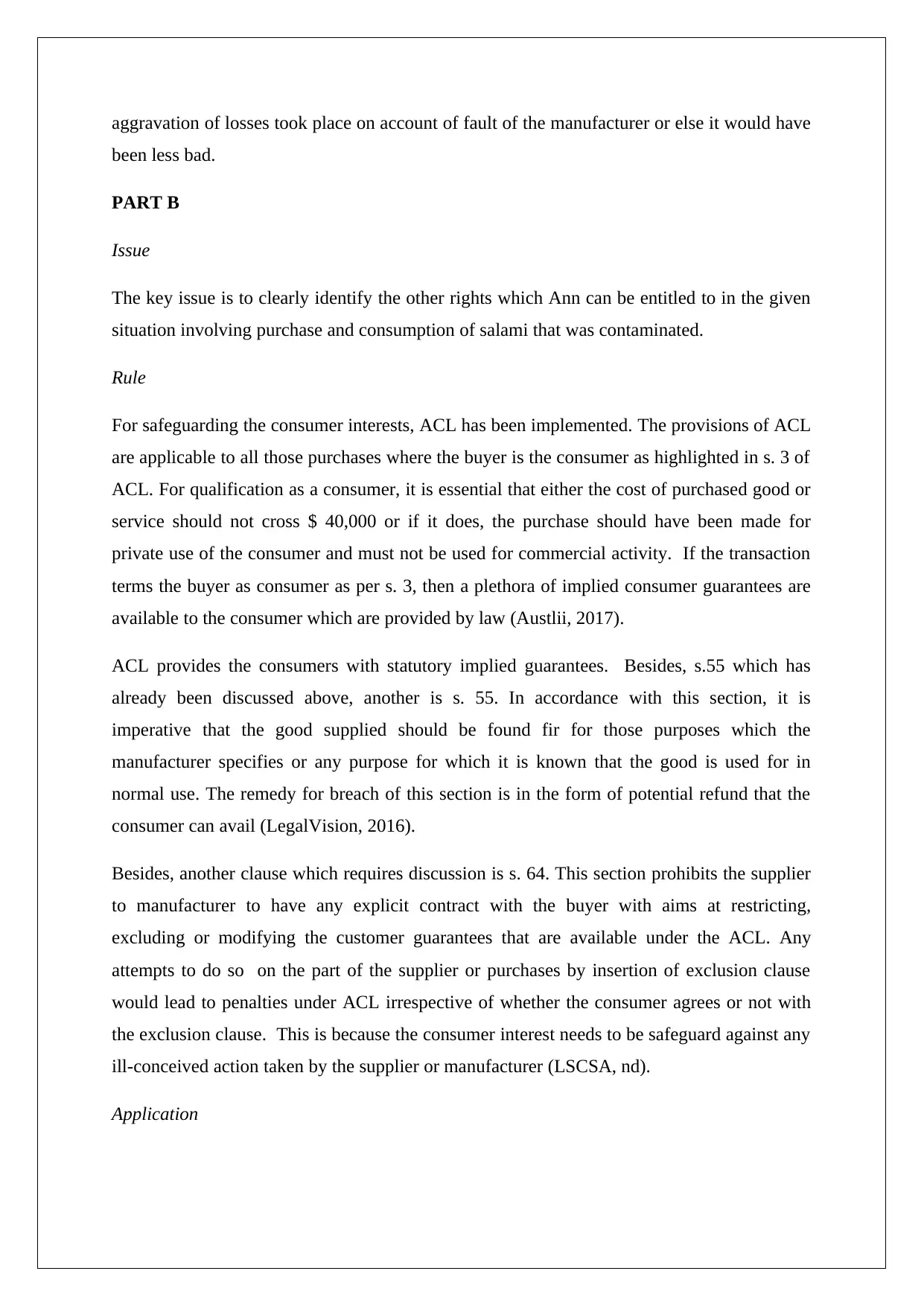
aggravation of losses took place on account of fault of the manufacturer or else it would have
been less bad.
PART B
Issue
The key issue is to clearly identify the other rights which Ann can be entitled to in the given
situation involving purchase and consumption of salami that was contaminated.
Rule
For safeguarding the consumer interests, ACL has been implemented. The provisions of ACL
are applicable to all those purchases where the buyer is the consumer as highlighted in s. 3 of
ACL. For qualification as a consumer, it is essential that either the cost of purchased good or
service should not cross $ 40,000 or if it does, the purchase should have been made for
private use of the consumer and must not be used for commercial activity. If the transaction
terms the buyer as consumer as per s. 3, then a plethora of implied consumer guarantees are
available to the consumer which are provided by law (Austlii, 2017).
ACL provides the consumers with statutory implied guarantees. Besides, s.55 which has
already been discussed above, another is s. 55. In accordance with this section, it is
imperative that the good supplied should be found fir for those purposes which the
manufacturer specifies or any purpose for which it is known that the good is used for in
normal use. The remedy for breach of this section is in the form of potential refund that the
consumer can avail (LegalVision, 2016).
Besides, another clause which requires discussion is s. 64. This section prohibits the supplier
to manufacturer to have any explicit contract with the buyer with aims at restricting,
excluding or modifying the customer guarantees that are available under the ACL. Any
attempts to do so on the part of the supplier or purchases by insertion of exclusion clause
would lead to penalties under ACL irrespective of whether the consumer agrees or not with
the exclusion clause. This is because the consumer interest needs to be safeguard against any
ill-conceived action taken by the supplier or manufacturer (LSCSA, nd).
Application
been less bad.
PART B
Issue
The key issue is to clearly identify the other rights which Ann can be entitled to in the given
situation involving purchase and consumption of salami that was contaminated.
Rule
For safeguarding the consumer interests, ACL has been implemented. The provisions of ACL
are applicable to all those purchases where the buyer is the consumer as highlighted in s. 3 of
ACL. For qualification as a consumer, it is essential that either the cost of purchased good or
service should not cross $ 40,000 or if it does, the purchase should have been made for
private use of the consumer and must not be used for commercial activity. If the transaction
terms the buyer as consumer as per s. 3, then a plethora of implied consumer guarantees are
available to the consumer which are provided by law (Austlii, 2017).
ACL provides the consumers with statutory implied guarantees. Besides, s.55 which has
already been discussed above, another is s. 55. In accordance with this section, it is
imperative that the good supplied should be found fir for those purposes which the
manufacturer specifies or any purpose for which it is known that the good is used for in
normal use. The remedy for breach of this section is in the form of potential refund that the
consumer can avail (LegalVision, 2016).
Besides, another clause which requires discussion is s. 64. This section prohibits the supplier
to manufacturer to have any explicit contract with the buyer with aims at restricting,
excluding or modifying the customer guarantees that are available under the ACL. Any
attempts to do so on the part of the supplier or purchases by insertion of exclusion clause
would lead to penalties under ACL irrespective of whether the consumer agrees or not with
the exclusion clause. This is because the consumer interest needs to be safeguard against any
ill-conceived action taken by the supplier or manufacturer (LSCSA, nd).
Application

It is known that the salami manufacturer has acted negligently and also that Ann is a
consumer under ACL. As the normal purpose along with that written on the packaging makes
the salami suitable for consumption, a breach of s. 55 has occurred since the defective salami
does not comply with the same. Further, considering that under s. 260, this is a major failure,
hence, Ann can demand 100% refund from the supplier.
Also, salami supplier has an exclusion clause in place as per which the supplier’s maximum
liability is limited to the product price refund with no liabilities over and above. This clearly
rules out any negligence related liability on the part of the supermarket when defective items
may be provided. As a result, the presence of exclusion clause results in liability limitation
and consequent violation of s. 64. Therefore, the supplier may be levied penalty for the
breach of s. 64 and would also have to bear a higher liability if any statutory consumer
guarantee is breached even though there is a exclusion clause.
Conclusion
In accordance with the discussion carried out above, a refund can be demanded under s.55
breach. Also, the supplier has breached s. 64 and hence liability would not be limited and the
provisions of ACL would continue to apply despite the exclusion clause contents.
Question 2
Issue
The major concern is to analyse if the negligence tort is established with regards to the given
case facts where Shanti works for U-Bewt Shoes factory and had to suffer damages on
account of the manager’s negligent conduct.
Law
In order to establish the presence of negligence tort, it is imperative for three conditions to be
fulfilled. The first one relates to the presence of a duty to care on the part of defendant. The
second one relates to the breach of the duty to care which is established in step 1 owing to
negligent conduct of the defendant (Latimer, 2016). This breach of duty or failure to take
necessary action should lead to damage being incurred by the plaintiff (Gibson and Fraser,
2014).
consumer under ACL. As the normal purpose along with that written on the packaging makes
the salami suitable for consumption, a breach of s. 55 has occurred since the defective salami
does not comply with the same. Further, considering that under s. 260, this is a major failure,
hence, Ann can demand 100% refund from the supplier.
Also, salami supplier has an exclusion clause in place as per which the supplier’s maximum
liability is limited to the product price refund with no liabilities over and above. This clearly
rules out any negligence related liability on the part of the supermarket when defective items
may be provided. As a result, the presence of exclusion clause results in liability limitation
and consequent violation of s. 64. Therefore, the supplier may be levied penalty for the
breach of s. 64 and would also have to bear a higher liability if any statutory consumer
guarantee is breached even though there is a exclusion clause.
Conclusion
In accordance with the discussion carried out above, a refund can be demanded under s.55
breach. Also, the supplier has breached s. 64 and hence liability would not be limited and the
provisions of ACL would continue to apply despite the exclusion clause contents.
Question 2
Issue
The major concern is to analyse if the negligence tort is established with regards to the given
case facts where Shanti works for U-Bewt Shoes factory and had to suffer damages on
account of the manager’s negligent conduct.
Law
In order to establish the presence of negligence tort, it is imperative for three conditions to be
fulfilled. The first one relates to the presence of a duty to care on the part of defendant. The
second one relates to the breach of the duty to care which is established in step 1 owing to
negligent conduct of the defendant (Latimer, 2016). This breach of duty or failure to take
necessary action should lead to damage being incurred by the plaintiff (Gibson and Fraser,
2014).
⊘ This is a preview!⊘
Do you want full access?
Subscribe today to unlock all pages.

Trusted by 1+ million students worldwide
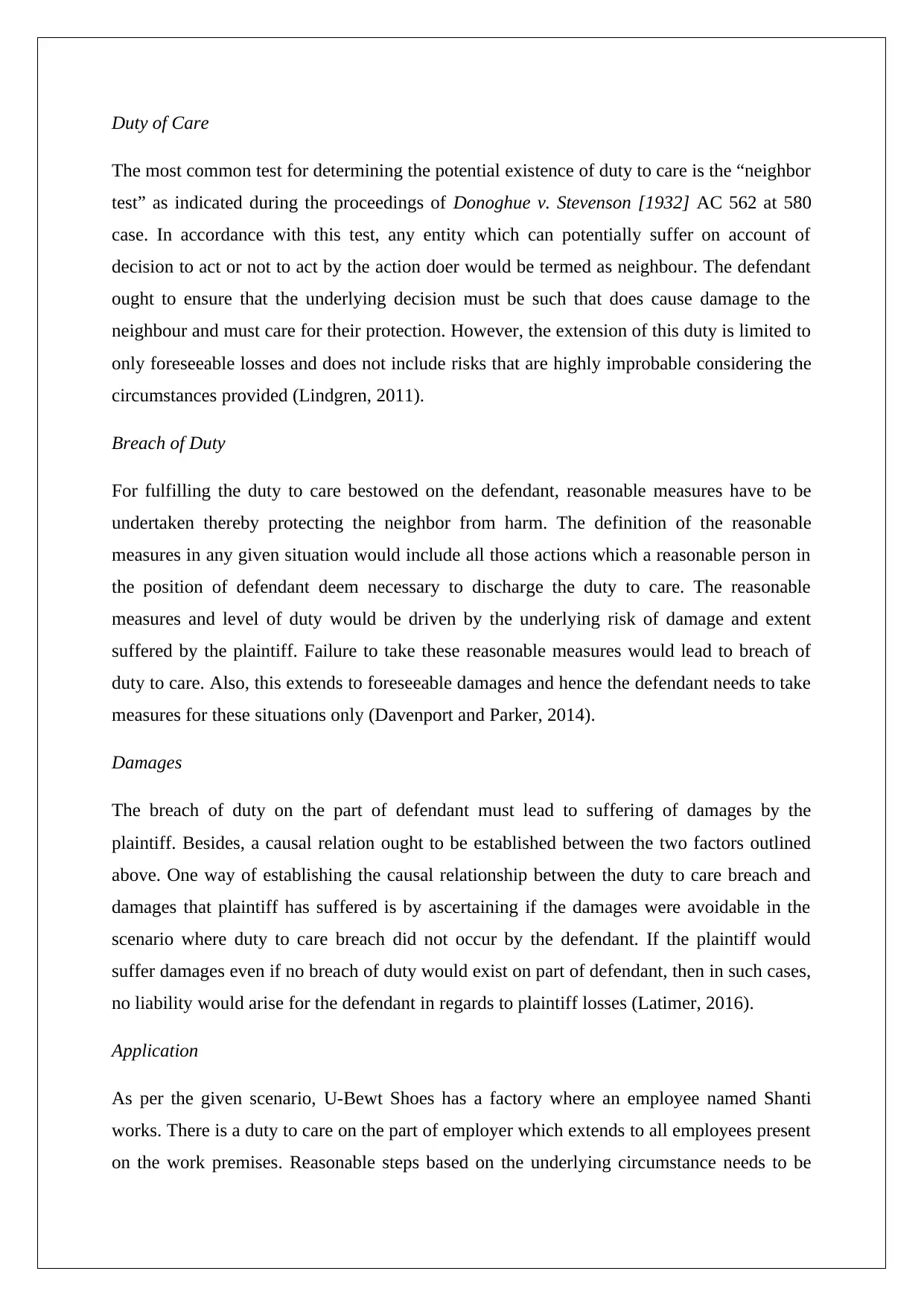
Duty of Care
The most common test for determining the potential existence of duty to care is the “neighbor
test” as indicated during the proceedings of Donoghue v. Stevenson [1932] AC 562 at 580
case. In accordance with this test, any entity which can potentially suffer on account of
decision to act or not to act by the action doer would be termed as neighbour. The defendant
ought to ensure that the underlying decision must be such that does cause damage to the
neighbour and must care for their protection. However, the extension of this duty is limited to
only foreseeable losses and does not include risks that are highly improbable considering the
circumstances provided (Lindgren, 2011).
Breach of Duty
For fulfilling the duty to care bestowed on the defendant, reasonable measures have to be
undertaken thereby protecting the neighbor from harm. The definition of the reasonable
measures in any given situation would include all those actions which a reasonable person in
the position of defendant deem necessary to discharge the duty to care. The reasonable
measures and level of duty would be driven by the underlying risk of damage and extent
suffered by the plaintiff. Failure to take these reasonable measures would lead to breach of
duty to care. Also, this extends to foreseeable damages and hence the defendant needs to take
measures for these situations only (Davenport and Parker, 2014).
Damages
The breach of duty on the part of defendant must lead to suffering of damages by the
plaintiff. Besides, a causal relation ought to be established between the two factors outlined
above. One way of establishing the causal relationship between the duty to care breach and
damages that plaintiff has suffered is by ascertaining if the damages were avoidable in the
scenario where duty to care breach did not occur by the defendant. If the plaintiff would
suffer damages even if no breach of duty would exist on part of defendant, then in such cases,
no liability would arise for the defendant in regards to plaintiff losses (Latimer, 2016).
Application
As per the given scenario, U-Bewt Shoes has a factory where an employee named Shanti
works. There is a duty to care on the part of employer which extends to all employees present
on the work premises. Reasonable steps based on the underlying circumstance needs to be
The most common test for determining the potential existence of duty to care is the “neighbor
test” as indicated during the proceedings of Donoghue v. Stevenson [1932] AC 562 at 580
case. In accordance with this test, any entity which can potentially suffer on account of
decision to act or not to act by the action doer would be termed as neighbour. The defendant
ought to ensure that the underlying decision must be such that does cause damage to the
neighbour and must care for their protection. However, the extension of this duty is limited to
only foreseeable losses and does not include risks that are highly improbable considering the
circumstances provided (Lindgren, 2011).
Breach of Duty
For fulfilling the duty to care bestowed on the defendant, reasonable measures have to be
undertaken thereby protecting the neighbor from harm. The definition of the reasonable
measures in any given situation would include all those actions which a reasonable person in
the position of defendant deem necessary to discharge the duty to care. The reasonable
measures and level of duty would be driven by the underlying risk of damage and extent
suffered by the plaintiff. Failure to take these reasonable measures would lead to breach of
duty to care. Also, this extends to foreseeable damages and hence the defendant needs to take
measures for these situations only (Davenport and Parker, 2014).
Damages
The breach of duty on the part of defendant must lead to suffering of damages by the
plaintiff. Besides, a causal relation ought to be established between the two factors outlined
above. One way of establishing the causal relationship between the duty to care breach and
damages that plaintiff has suffered is by ascertaining if the damages were avoidable in the
scenario where duty to care breach did not occur by the defendant. If the plaintiff would
suffer damages even if no breach of duty would exist on part of defendant, then in such cases,
no liability would arise for the defendant in regards to plaintiff losses (Latimer, 2016).
Application
As per the given scenario, U-Bewt Shoes has a factory where an employee named Shanti
works. There is a duty to care on the part of employer which extends to all employees present
on the work premises. Reasonable steps based on the underlying circumstance needs to be
Paraphrase This Document
Need a fresh take? Get an instant paraphrase of this document with our AI Paraphraser
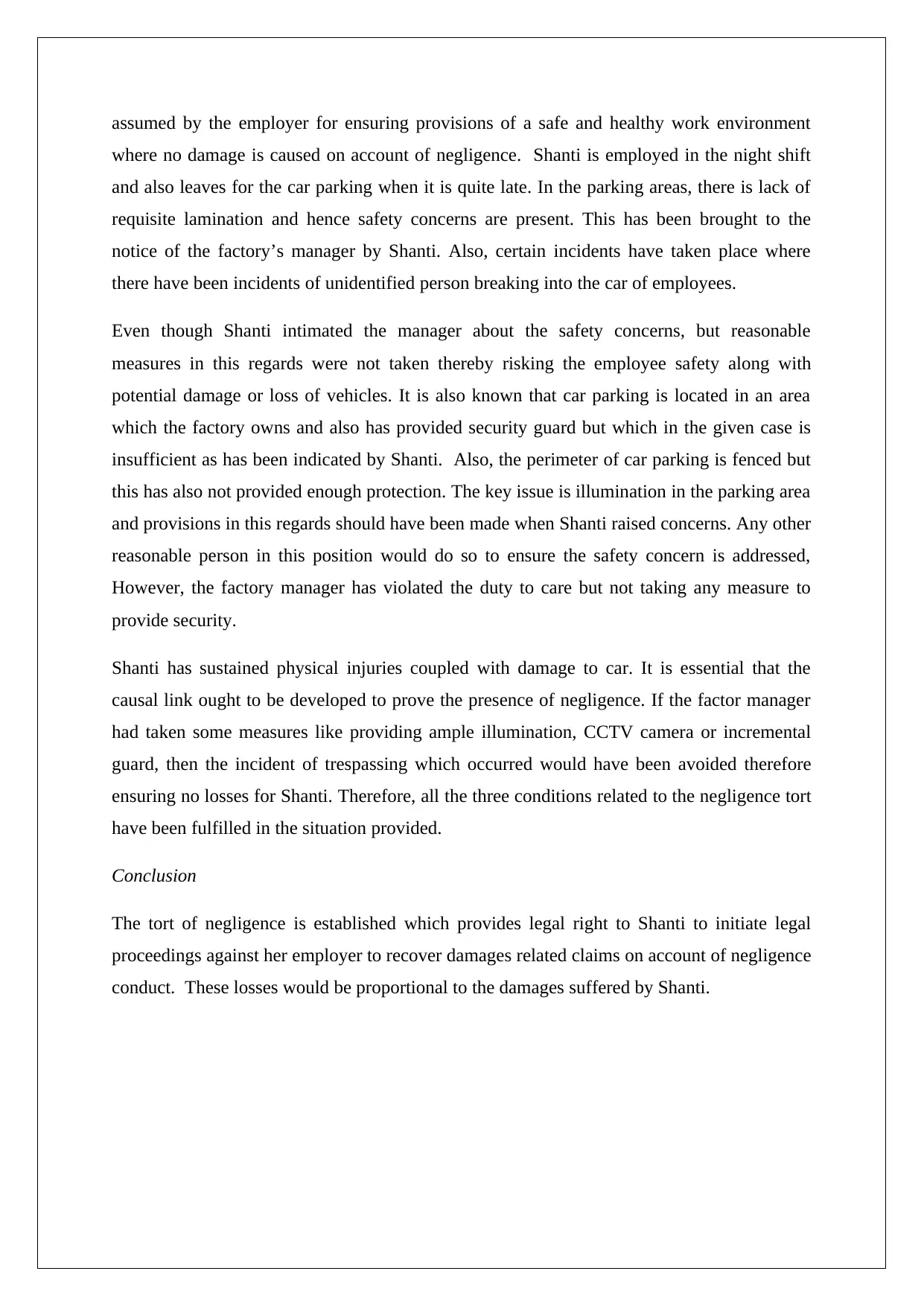
assumed by the employer for ensuring provisions of a safe and healthy work environment
where no damage is caused on account of negligence. Shanti is employed in the night shift
and also leaves for the car parking when it is quite late. In the parking areas, there is lack of
requisite lamination and hence safety concerns are present. This has been brought to the
notice of the factory’s manager by Shanti. Also, certain incidents have taken place where
there have been incidents of unidentified person breaking into the car of employees.
Even though Shanti intimated the manager about the safety concerns, but reasonable
measures in this regards were not taken thereby risking the employee safety along with
potential damage or loss of vehicles. It is also known that car parking is located in an area
which the factory owns and also has provided security guard but which in the given case is
insufficient as has been indicated by Shanti. Also, the perimeter of car parking is fenced but
this has also not provided enough protection. The key issue is illumination in the parking area
and provisions in this regards should have been made when Shanti raised concerns. Any other
reasonable person in this position would do so to ensure the safety concern is addressed,
However, the factory manager has violated the duty to care but not taking any measure to
provide security.
Shanti has sustained physical injuries coupled with damage to car. It is essential that the
causal link ought to be developed to prove the presence of negligence. If the factor manager
had taken some measures like providing ample illumination, CCTV camera or incremental
guard, then the incident of trespassing which occurred would have been avoided therefore
ensuring no losses for Shanti. Therefore, all the three conditions related to the negligence tort
have been fulfilled in the situation provided.
Conclusion
The tort of negligence is established which provides legal right to Shanti to initiate legal
proceedings against her employer to recover damages related claims on account of negligence
conduct. These losses would be proportional to the damages suffered by Shanti.
where no damage is caused on account of negligence. Shanti is employed in the night shift
and also leaves for the car parking when it is quite late. In the parking areas, there is lack of
requisite lamination and hence safety concerns are present. This has been brought to the
notice of the factory’s manager by Shanti. Also, certain incidents have taken place where
there have been incidents of unidentified person breaking into the car of employees.
Even though Shanti intimated the manager about the safety concerns, but reasonable
measures in this regards were not taken thereby risking the employee safety along with
potential damage or loss of vehicles. It is also known that car parking is located in an area
which the factory owns and also has provided security guard but which in the given case is
insufficient as has been indicated by Shanti. Also, the perimeter of car parking is fenced but
this has also not provided enough protection. The key issue is illumination in the parking area
and provisions in this regards should have been made when Shanti raised concerns. Any other
reasonable person in this position would do so to ensure the safety concern is addressed,
However, the factory manager has violated the duty to care but not taking any measure to
provide security.
Shanti has sustained physical injuries coupled with damage to car. It is essential that the
causal link ought to be developed to prove the presence of negligence. If the factor manager
had taken some measures like providing ample illumination, CCTV camera or incremental
guard, then the incident of trespassing which occurred would have been avoided therefore
ensuring no losses for Shanti. Therefore, all the three conditions related to the negligence tort
have been fulfilled in the situation provided.
Conclusion
The tort of negligence is established which provides legal right to Shanti to initiate legal
proceedings against her employer to recover damages related claims on account of negligence
conduct. These losses would be proportional to the damages suffered by Shanti.
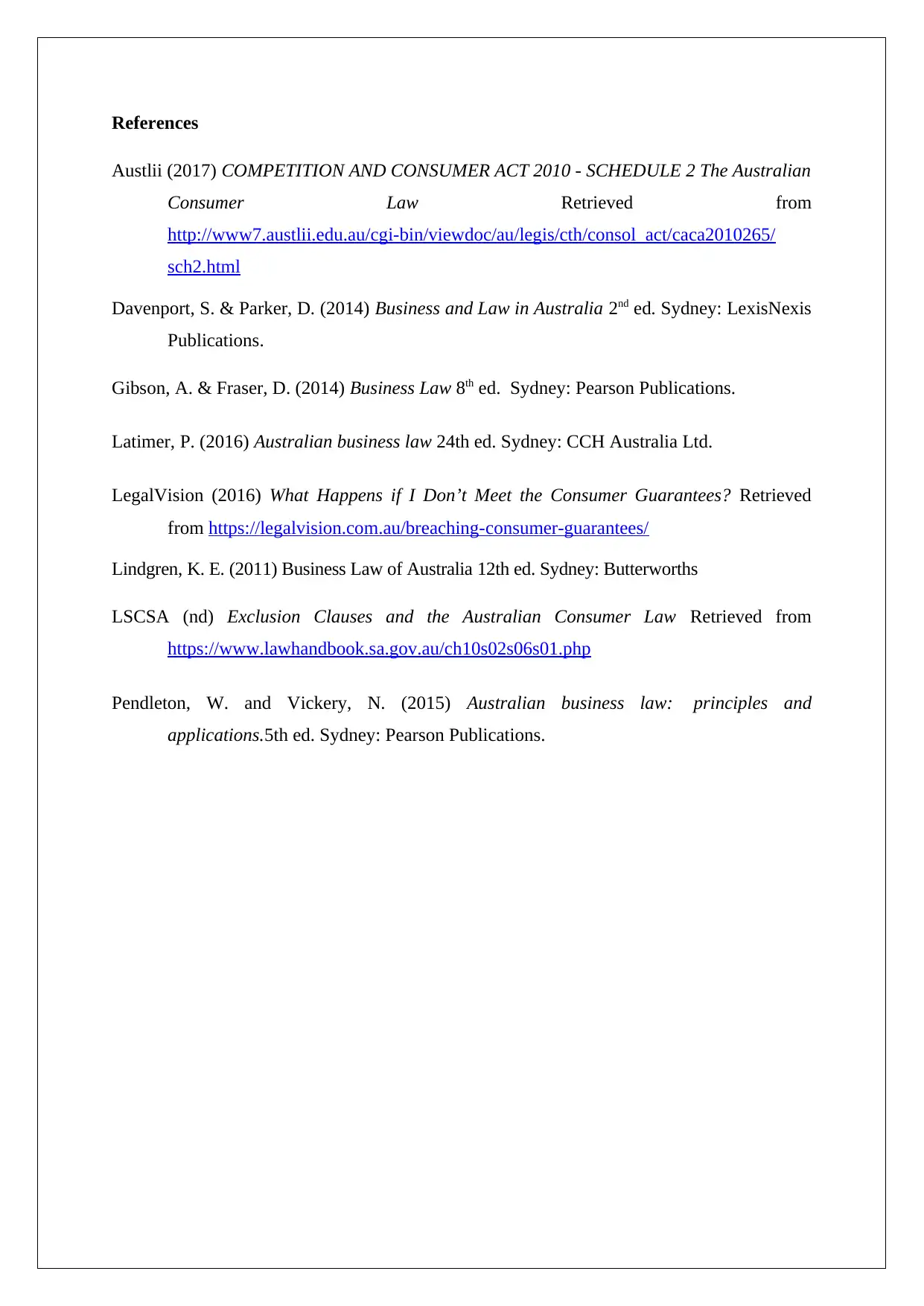
References
Austlii (2017) COMPETITION AND CONSUMER ACT 2010 - SCHEDULE 2 The Australian
Consumer Law Retrieved from
http://www7.austlii.edu.au/cgi-bin/viewdoc/au/legis/cth/consol_act/caca2010265/
sch2.html
Davenport, S. & Parker, D. (2014) Business and Law in Australia 2nd ed. Sydney: LexisNexis
Publications.
Gibson, A. & Fraser, D. (2014) Business Law 8th ed. Sydney: Pearson Publications.
Latimer, P. (2016) Australian business law 24th ed. Sydney: CCH Australia Ltd.
LegalVision (2016) What Happens if I Don’t Meet the Consumer Guarantees? Retrieved
from https://legalvision.com.au/breaching-consumer-guarantees/
Lindgren, K. E. (2011) Business Law of Australia 12th ed. Sydney: Butterworths
LSCSA (nd) Exclusion Clauses and the Australian Consumer Law Retrieved from
https://www.lawhandbook.sa.gov.au/ch10s02s06s01.php
Pendleton, W. and Vickery, N. (2015) Australian business law: principles and
applications.5th ed. Sydney: Pearson Publications.
Austlii (2017) COMPETITION AND CONSUMER ACT 2010 - SCHEDULE 2 The Australian
Consumer Law Retrieved from
http://www7.austlii.edu.au/cgi-bin/viewdoc/au/legis/cth/consol_act/caca2010265/
sch2.html
Davenport, S. & Parker, D. (2014) Business and Law in Australia 2nd ed. Sydney: LexisNexis
Publications.
Gibson, A. & Fraser, D. (2014) Business Law 8th ed. Sydney: Pearson Publications.
Latimer, P. (2016) Australian business law 24th ed. Sydney: CCH Australia Ltd.
LegalVision (2016) What Happens if I Don’t Meet the Consumer Guarantees? Retrieved
from https://legalvision.com.au/breaching-consumer-guarantees/
Lindgren, K. E. (2011) Business Law of Australia 12th ed. Sydney: Butterworths
LSCSA (nd) Exclusion Clauses and the Australian Consumer Law Retrieved from
https://www.lawhandbook.sa.gov.au/ch10s02s06s01.php
Pendleton, W. and Vickery, N. (2015) Australian business law: principles and
applications.5th ed. Sydney: Pearson Publications.
⊘ This is a preview!⊘
Do you want full access?
Subscribe today to unlock all pages.

Trusted by 1+ million students worldwide
1 out of 9
Related Documents
Your All-in-One AI-Powered Toolkit for Academic Success.
+13062052269
info@desklib.com
Available 24*7 on WhatsApp / Email
![[object Object]](/_next/static/media/star-bottom.7253800d.svg)
Unlock your academic potential
Copyright © 2020–2025 A2Z Services. All Rights Reserved. Developed and managed by ZUCOL.




